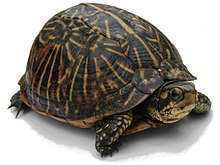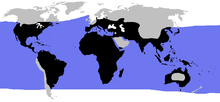order of reptiles characterized by a shell From Wikipedia, the free encyclopedia
Turtles are one of the many reptiles on earth. They have a hard shell, which is useful for camouflage and protection from other animals.
| Testudines | |
|---|---|
 | |
| Florida box turtle (Terrapene carolina) | |
| Scientific classification | |
| Domain: | Eukaryota |
| Kingdom: | Animalia |
| Phylum: | Chordata |
| Class: | Reptilia |
| Clade: | Perichelydia |
| Order: | Testudines Batsch 1788 [2] |
| Subgroups | |
|
Cryptodira | |
| Diversity | |
| 14 living families with 356 species | |
 | |
| Blue: sea turtles, black: land turtles | |
There are two types of turtles: side-necked turtles and hidden neck turtles. Side-necked turtles have long necks, but hidden neck turtles have very small necks.
There are about 356 species of turtles living on land in all continents except Antarctica. They can live in both salt water and fresh water.
Testudines (which includes turtles) includes both living and extinct kinds. The earliest fossil of a turtle was found in China from the early Upper Triassic age. The fossil was from about 220 million years ago. Turtles are one of the oldest reptiles that are not extinct. Turtles have been on earth for longer than lizards, snakes and crocodiles. Turtles come from ancient turtles, which had spiked shells.
Turtles are almost everywhere in the world. A lot of the turtle species alive today are endangered.[3]
Although the word turtle is widely used to describe all testudines, it is also common to see them called terrapins, tortoises or sea turtles. How these names are used depends on the type of English.
To avoid confusion, the word "chelonian" is popular among some who work with these animals.[5] Unfortunately, Chelonia is also the name of a particular type of turtle, so this conflicts with "testudines".
Although many turtles spend a lot of their lives underwater, all turtles and tortoises breathe air and must come to the surface to refill their lungs. Some spend their whole lives on dry land.
Aquatic respiration in Australian freshwater turtles is being studied. Some kinds of turtle have large cloacal holes that are lined with many finger-like things. These things, called papillae, have a lot of blood in them, and increase the surface area of the cloaca. The turtles get oxygen from the water using these papillae, in the same way that fish use gills.

Like other reptiles, turtles lay eggs which are slightly soft and leathery. The eggs of the largest kinds of turtle are shaped like spheres. Other turtles have eggs that are shaped more like chicken eggs. Sea turtles lay their eggs on dry, sandy beaches. Turtles can take many years to reach breeding age, and in many cases breed every few years rather than every year.
Some kinds of turtle have a sex determination that depends on temperature. This decides whether an egg develops into a male or a female. A higher temperature makes a female. A lower temperature makes a male. Large numbers of eggs are deposited in holes dug into mud or sand. They are then covered and left to incubate by themselves. When the turtles hatch, they go to the surface and head toward the water. No turtle mother cares for its young.
Researchers discovered that a turtle's organs do not get old over time. Unlike most other animals, they found that the liver, lungs, and kidneys of a century-old turtle are almost the same as those of a younger turtle. This has made genetic researchers begin studying turtle genetics for longevity genes.[6]
Turtles are put into two groups from the way they hide their heads into their shells. The Cryptodira (hidden neck turtles) pull their heads straight into their shells by folding their necks back under their spines. They have very small necks. The Pleurodira (side-necked turtles), now found only in fresh water places in the Southern hemisphere, fold their necks to the side. The important adaptation of hiding their heads came from turtles in the past which were not able to do this. This adds to their defence against predators.
Turtles have a hard beak. They use their jaws to cut and chew food. Turtles have hard edges called horny ridges that cover their upper and lower jaws. These ridges are different from teeth, which turtles do not have. Carnivorous turtles tend to have knife-sharp ridges that help them cut through meat. Herbivorous turtles have serrated-edged ridges that help them cut through tough plants. Turtles use their tongues to swallow food, but unlike most reptiles, they cannot stick out their tongues to catch food.
The upper shell of the turtle is called the carapace. The lower shell that covers the belly is called the plastron. The carapace and plastron are joined on the turtle's sides by bony structures called bridges.
The inside of a turtle's shell has about 60 bones. It includes parts of the spine and ribs, meaning the turtle cannot crawl out of its shell.
The largest kind is a marine turtle called the great leatherback sea turtle. This can have a shell length of 200 cm (80 inches) and can weigh over 900 kg (2,000 lb, or 1 ton). Freshwater turtles tend to be smaller. The largest kind, the Asian giant softshell turtle Pelochelys cantorii, can be up to 200 cm or 80 in (Das, 1991). This is bigger than even the better-known alligator snapping turtle, the largest kind of turtle in North America. This can have a shell length of up to 80 cm (311⁄2 in) and a weight of about 60 kg (170 lb).
The largest fossil turtle, Archelon, was more than twice as long as the leatherback, at up to 4.5 metres.


The earliest turtle fossils come from Upper Triassic of the Mesozoic era, about 220 million years ago.[7] Their shell came from bony extensions of their backbones and broad ribs that became larger and grew together to make a complete shell. This adaptation was very useful and has been around for a long time. It helped protect turtles as they evolved over many years, even when the bony part of the shell was not complete. The turtle family has survived many changes in the seas and several extinction events.
Fossils of the freshwater Odontochelys semitestacea or "half-shelled turtle with teeth", from the later Triassic, were found in southwest China. Odontochelys shows a complete bony plastron and an incomplete carapace. This is like baby turtles in embryonic development today.[8] By the Upper Jurassic, turtles had radiated widely, and their fossil history becomes easier to read.
We do not know exactly where turtles came from. Early amniotes had no openings in the skull behind the eyes. Holes started to appear in both Sauropsid and Synapsid skulls. They made the skull lighter, gave attachment points for muscles, and gave room for muscle bulges. But turtles do not have these holes in their skulls. They were called 'anapsids', meaning 'no openings'.
It may be that turtles came from sauropsids which had skull openings, but turtles lost these openings as they made heavy defensive armour.[9] All molecular studies show that turtles are diapsids; some think that turtles are either archosaurs,[10] or are a sister group to living archosaurs.[11][12][13][14][15]
The earliest known fully shelled turtles are the late Triassic Odontochelys, Chinlechelys and Proganochelys. The first-named genus was aquatic, but the second was probably terrestrial.[16] They already had many advanced turtle traits, and probably had millions of years of turtle evolution and species in their ancestry. They had a long neck and could not pull their heads into their shell. Odontochelys had a long, spiked tail ending in a club. Ankylosaurs also have similar things because of convergent evolution.
Seamless Wikipedia browsing. On steroids.
Every time you click a link to Wikipedia, Wiktionary or Wikiquote in your browser's search results, it will show the modern Wikiwand interface.
Wikiwand extension is a five stars, simple, with minimum permission required to keep your browsing private, safe and transparent.